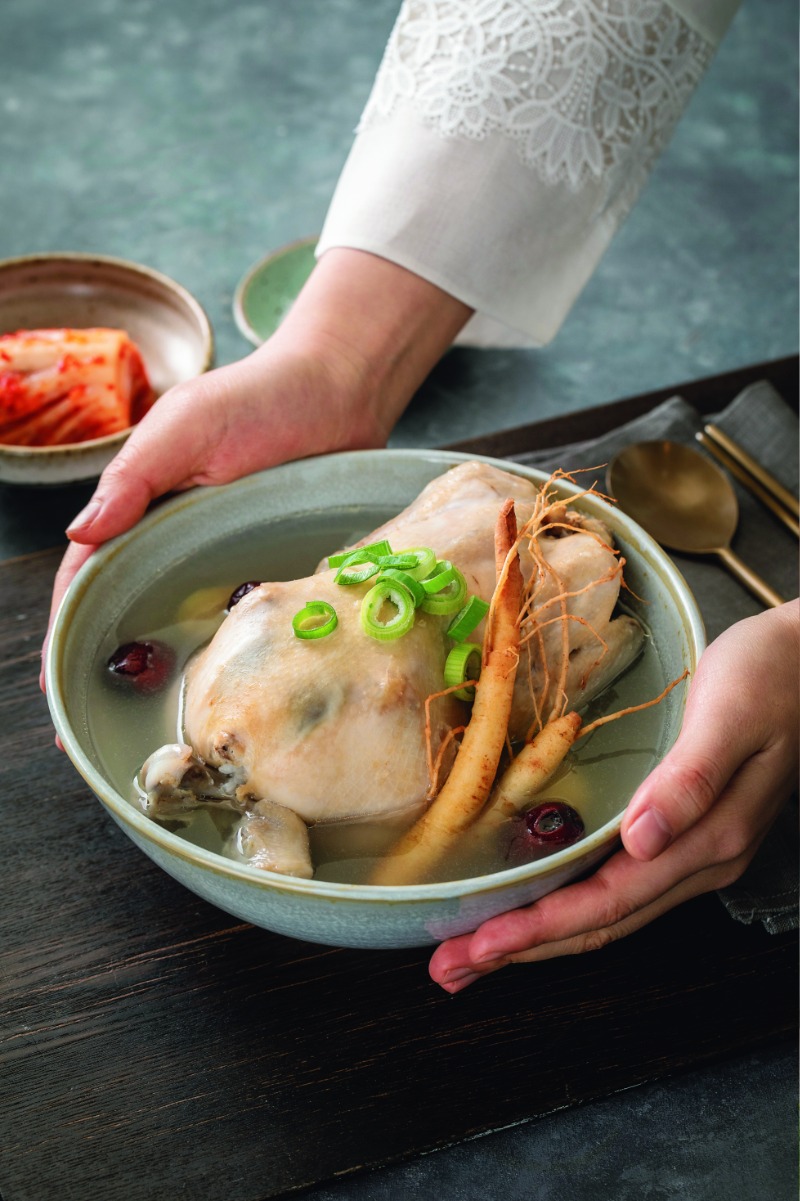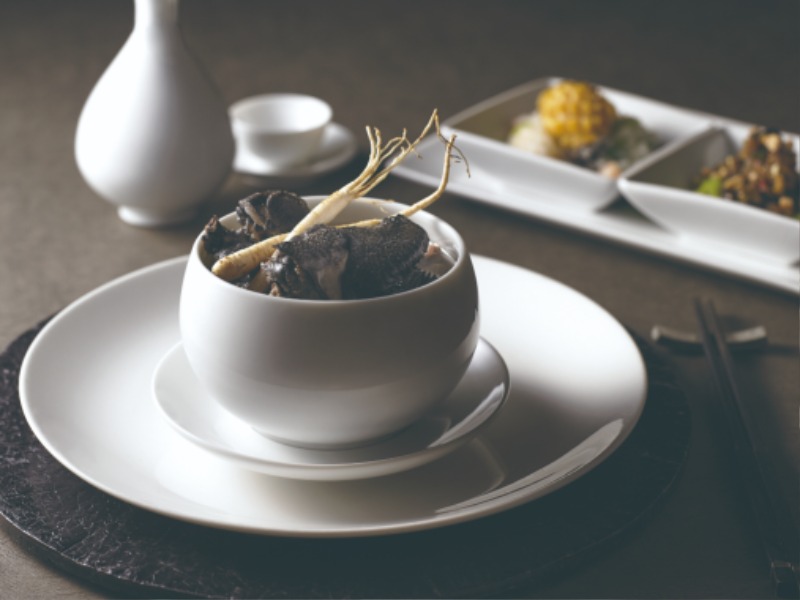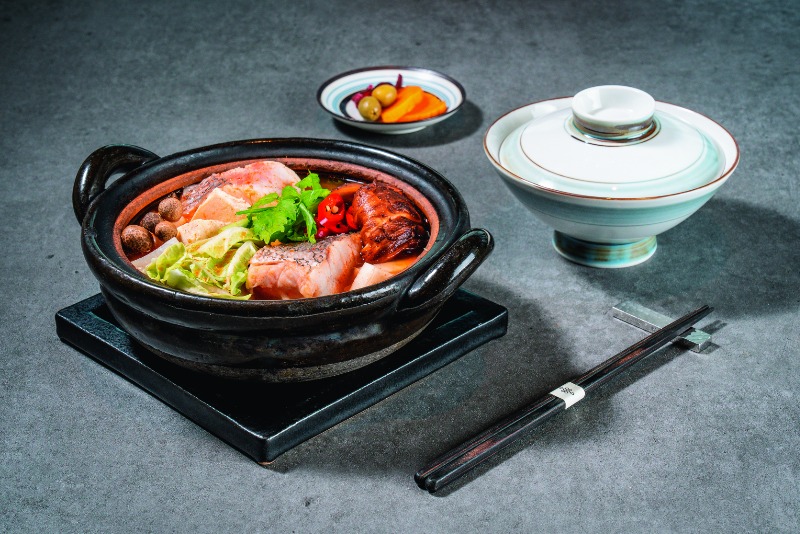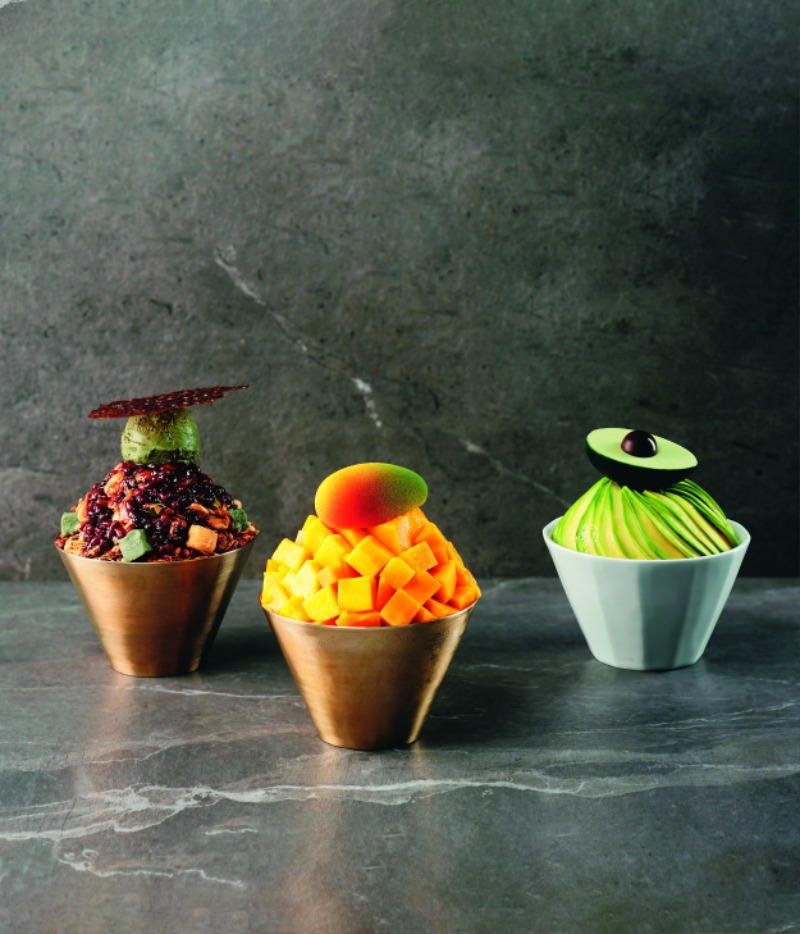During the dog days of summer when the scorching heat saps the energy, Koreans turn to boyangsik (nourishing, protein-rich foods) to restore their vigor. Recently, people have been heading to high-end hotels to enjoy these energy-boosting dishes amid increased health consciousness prompted by the coronavirus pandemic and the trend of “small luxury” consumption.

Samgyetang is unquestionably the most popular summertime energy-boosting dish. It is made by first cleaning and removing the chicken’s internal organs, then stuffing the cavity with various ingredients, such as glutinous rice, jujubes, fresh ginseng and whole garlic bulbs, and slowly boiling it all in a pot.
© TongRo Images
At the height of summer when temperatures soar above 30 degrees Celsius, even a little physical activity makes you weary. Work productivity drops too. Gulping down a cool drink doesn’t offer much relief for summertime lethargy, and while cold foods can help cool the body down temporarily, they don’t have the desired rejuvenating effect. There are many ways of coping with the sweltering heat and restoring depleted energy, and for most Koreans, their go-to is a piping hot and hearty dish.
Boyangsik refers to food that boosts stamina and replenishes the body’s nutrients. Major examples include samgyetang (ginseng chicken soup), chueotang (loach soup), mineotang (croaker soup), jangeotang (eel soup) and jeonboktang (abalone soup).
Among these, samgyetang, made with a whole young chicken stuffed with ginseng, definitely tops the list. The protein-rich chicken paired with ginseng, touted for its medicinal effects, is the perfect dish to beat the summer heat. In other classic summertime dishes, seafood is a particularly popular ingredient, thanks to the waters that surround Korea on three sides.
Luxury hotels aren’t likely to miss out on the trend for summertime energy foods. When the heat rises, they race to offer specialty dishes prepared with the finest ingredients. These hotel dishes are in high demand as people grow increasingly health conscious throughout the ongoing pandemic. Another classic summer treat is bingsu (shaved ice dessert), and in recent years, premium variations d by hotels have become huge hits. Hotels have also launched meal kits of popular dishes that customers can enjoy from the comfort of home.
Samgyetang: Iconic Energy-boosting Dish
Korean meals invariably include a soup, broth or stew; some even refer to Korea as a “nation of soup.” There’s also the widely used Korean idiom “there’s no soup,” which means “there’s no gain or benefit.” Soup-based dishes have long been an indispensable part of Korea’s culinary culture.
Perhaps this is why, without doubt, samgyetang is the highlight on hotel menus in summer. The ginseng chicken soup served at hotels differs slightly from the version commonly seen at ordinary restaurants. For starters, the chickens are special – either eco-friendly or of a native Korean breed, free-range or raised on organic feed. Add a palm-sized abalone to the soup and the flavors of the land and sea dance in perfect harmony.
The common recipe for samgyetang is to first clean and remove the chicken’s internal organs, then stuff the cavity with various ingredients such as glutinous rice, chestnuts and jujubes, and boil it all in a pot. But some hotels have developed their own special recipes to give the dish a distinctive flavor. In one example, the chicken meat is removed from the bone in thin slices and cooked with abalone, fresh ginseng and scaly hedgehog mushrooms (neungi boseot) at a low temperature. Milk vetch root, garlic and jujubes are then added before the whole lot is simmered for over three hours. Abalone is rich in protein and minerals; fresh ginseng and neungi mushrooms are also high in nutrients. Milk vetch root, garlic and jujubes are recognized for their ability to boost energy. One sip of the hot broth washes away the summer heat.

Baekbong ogol chicken and ginseng soup is a specialty dish that was introduced in 2016 by the Shilla Hotel’s Chinese restaurant. Baekbong ogol is a breed of chicken with white feathers and black skin and bones, regarded as a precious health food from old times. The broth is light yet rich in flavor.
© HOTEL SHILLA CO., LTD.
Mineotang: Delectable Fish Delicacy
Mineotang is a fancy, soup-based dish. Fish tend to taste best right before they lay eggs, which is when they’re meatiest and richest in nutrients. Since croakers spawn between July and September, the ideal time to eat them is summer, from June to August.
Croaker dishes such as croaker soup and croaker sashimi have a short history among the ranks of beloved summertime dishes. Around 10 years ago, the fish was promoted in the media as a delicacy that Joseon Dynasty kings once dined on. Since then, it has become a staple on the menus of luxury hotels each summer. Croaker soup is made by boiling the fish with radish, napa cabbage, green onions and other ingredients in a broth flavored with dried kelp. The moment you taste it, the word “siwonhada” comes out of your mouth. Literally, this means “cool” – it expresses the refreshing feeling of eating hot food on a hot day, with beads of sweat forming on your forehead, skin cooling down as the sweat evaporates.
A side from croaker soup, high-end hotels serve up a wide variety of croaker-based specialties. Croaker and sea cucumber pyeonsu are cold, square-shaped dumplings that Koreans loved to eat in the past. A lot of care and effort goes into their preparation: the dough is rolled and cut into squares and filled with minced croaker, sea cucumber, mung bean sprouts and several other ingredients, then steamed. Another variation of croaker dumplings is made with wrappers of croaker skin. Meanwhile, croaker jeon is made by seasoning slices of the fish with salt, coating them with flour and egg batter, then pan-frying them in oil. And croaker sashimi served after being aged for six hours tastes divine.

Mineo maeuntang, a fish-based soup, is a delicacy served up this summer by HOMURAN, a restaurant at GRAVITY Seoul Pangyo (Autograph Collection).Made with a special sauce developed by the restaurant, the soup has a spicy but clean taste that brings out the flavor of croaker. Joseon Dynasty nobles considered food made with croaker, a premium fish, to be especially good for their health.
© JOSUN HOTELS & RESORTS Co.
Imjasutang: A Cold Delicacy
Not all summer nourishment is hot. Mulhoe, a dish of several kinds of fresh raw seafood and rice mixed together with a spicy sauce, is served ice cold. After finishing the rice, you pour water into the bowl and polish off what’s left. Mulhoe was originally eaten by fishermen out at sea, who could quickly whip up the dish on a boat with damaged fish that was unsuitable for sale. In contrast to its humble beginnings, hotels concoct lavish versions of mulhoe with expensive ingredients. The ingredients, seasonings and recipes vary by region. For example, soybean paste is used in Jeolla Province and on Jeju Island, while red pepper paste is used in Gyeongsang Province. The flavor variations are a gastronomic delight.
Whereas mulhoe was the food of commoners in the Joseon period, imjasutang (chilled chicken sesame soup) was a summer delicacy enjoyed by the king and other royalty. And it’s more than just a treat for the taste buds; the colorful garnish of cucumber, yellow egg strips, red peppers and mushrooms is a feast for the eyes. The chicken is boiled until tender, then shredded into thin pieces and seasoned. The meat is then placed in a bowl with the garnish and cold broth is poured over the top. This broth is made with chicken stock mixed with ground roasted sesame seeds, which add a delightful nutty flavor.

Grand InterContinental Seoul Parnas’ summer premium bingsu. From left, mugwort bingsu made with mugwort ice cream, red beans and condensed milk; apple mango bingsuwith a generous topping of Jeju apple mango slices; and avocado vegan bingsu with coconut, tofu and avocado.
© PARNAS HOTEL Co., Ltd.
Bingsu: Small Luxury for the Taste Buds
The desire to attract more customers makes hotel chefs go to great lengths toenergy-boosting summer specialties, even combing through ancient literature. But people don’t always turn to nourishing health foods to fight the summer heat. An all-time summer favorite is the ice dessert bingsu.
In the 1930s and 1940s, bingsuwas a popular street food sold by ice vendors who carried around blocks of ice in a handcart. They would add red beans and food coloring to finely ground ice and sell it to customers. In the 1970s, this classic summer treat moved from the streets into upscale bakeries. Early forms of bingsuconsisted mainly of shaved ice with red beans and condensed milk. In the 1990s, canned fruit became a popular topping, and in the 2000s, “snowflake bingsu” made with ice shavings resembling snowflakes and “daepae bingsu” with thinly sliced ice became huge hits.
Trends began to change when luxury hotels launched premium bingsu around seven to eight years ago. Despite being four to ten times pricier than regular versions, people flock to hotels each summer to enjoy their signature bingsuvariations with lavish toppings ranging from the highest-grade honey to various berries and tropical fruits. The red beans used in the hotel versions are not canned but rather locally grown, high-quality beans with a more subtle sweetness.
Park Hyatt Seoul’s berry bingsu may have pioneered the premium bingsu trend, but it was the Shilla Hotel’s signature apple mango bingsu, with copious mango slices heaped in a bowl, that fueled the boom. Other hotels have followed suit, coming up with their own premium bingsu recipes. The hefty price, which can range from 60,000 to 80,000 won, doesn’t deter customers who want to treat themselves to a “small luxury.”
The star of mango bingsu is the apple mango, a tropical fruit loaded with vitamins. One bite fills the mouth with rich juice and sweet flavor. It also has a stronger scent compared to other fruits; some say that taking a mango to your nose and smelling its fruity aroma lifts your mood. Visual appeal is just as important as taste in enticing the appetite, and the golden-yellow color of mango flesh delights the eyes. Warming temperatures on the Korean peninsula have led to an increased production of apple mangoes on Jeju Island. With a richer flavor than imported mangoes, they have become a selling point for hotels that promote bingsu made with homegrown Jeju mangoes.
Many of us may be feeling down due to the ongoing pandemic, but one surefire way to lift your spirits is to treat yourself to a sweet and refreshing dessert like bingsu. The ice melting on your tongue and the sweetness of the red beans and fruit are a sure cure for the corona blues.